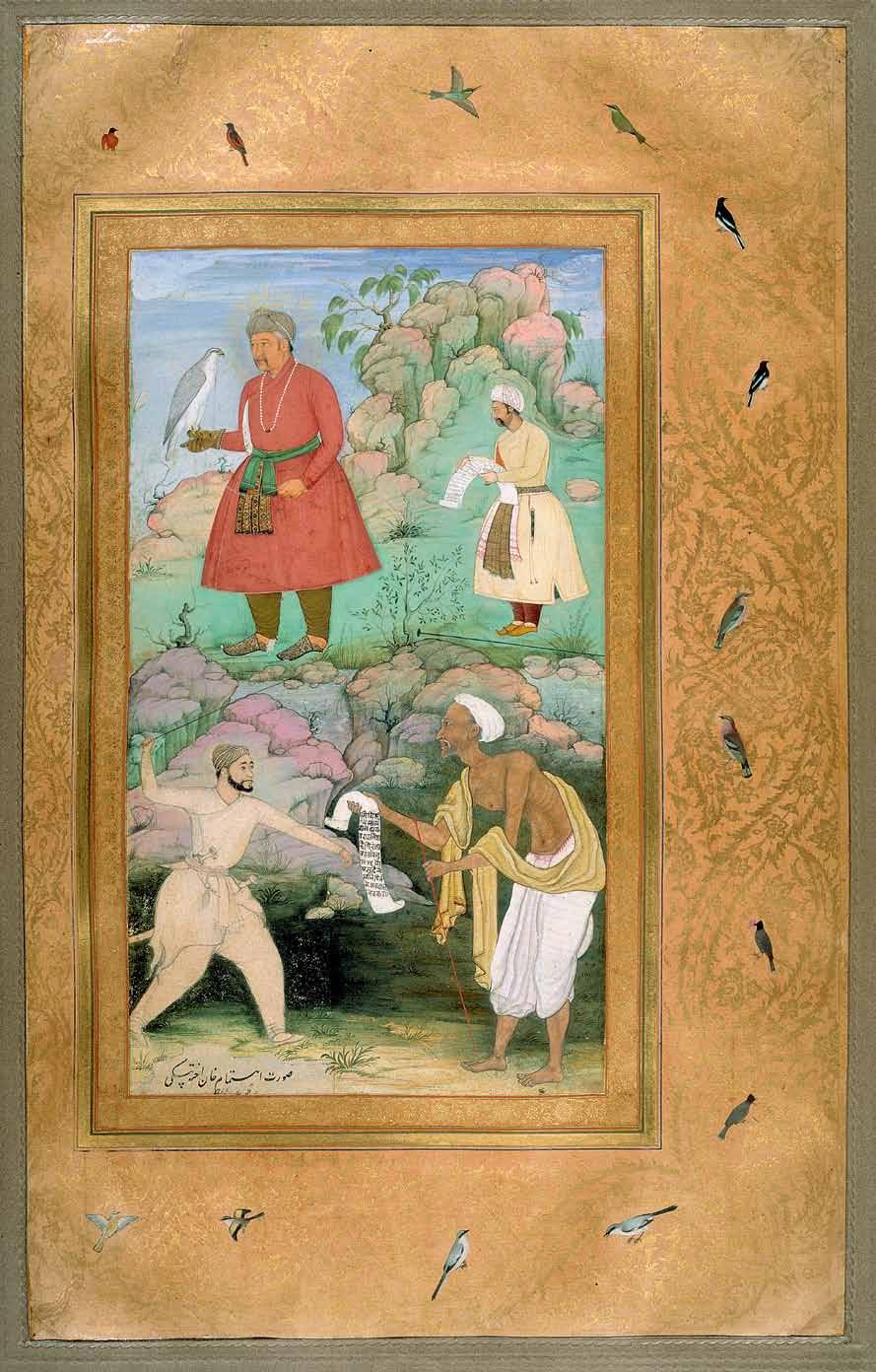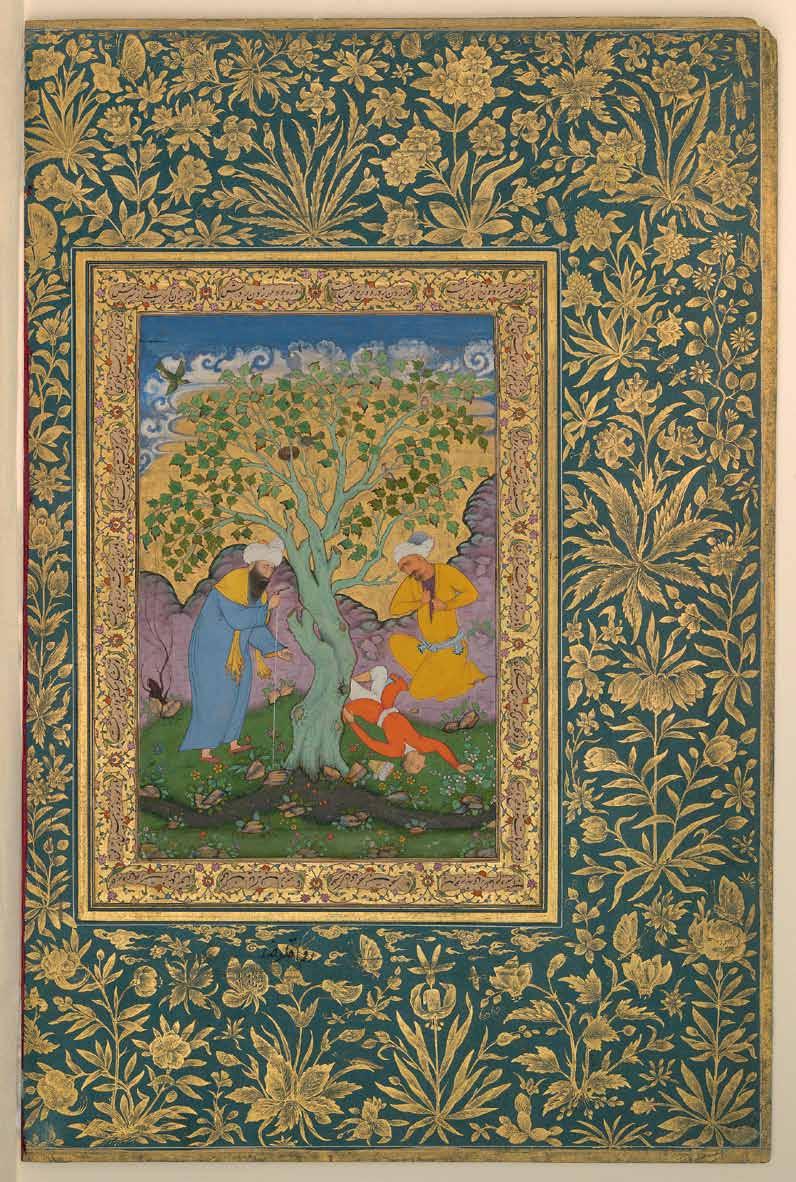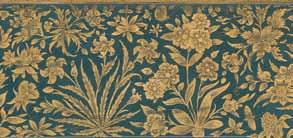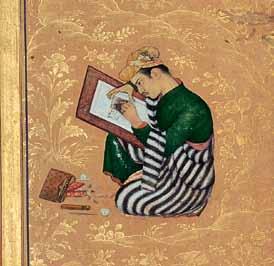
6 minute read
Masters of the Dispersed Bhagavata Purana
Keshav Das Active ca. 1570–1604/5, at the Mughal courts in Delhi, Lahore, Agra, and Allahabad
The Hindu painter Keshav Das was an early local entrant into Akbar’s atelier, probably at the instigation of the Iranian master painter Khwaja ‘Abd al-Samad, who oversaw the studio at this time and had been instrumental in recruiting widely in order to complete the monumental Hamzanama project (1557–58 to 1572–73). He proved to be a prolific artist, producing major contributions to many imperial volumes, including an
Advertisement
edition of the Ramayana (Jaipur Palace Museum) to which he contributed no less than thirty-five full-page compositions. 24 Akbar ranked Keshav Das fifth in the imperial studio, according to Abu’l Fazl’s official history of the reign. 25 While Mughal painters had a habit of inserting their self-portraits discreetly into the margins of crowd scenes, Keshav Das created an early self-portrait in which he is the sole subject (above) and a later work in which he shares the stage with his emperor and patron, Akbar (No. 25). Skilled in the Mughal conventions of blending the strong Indian palette with the soft pastel tonality of Timurid courtly styles, he was equally at ease applying these skills to Islamic, Hindu, or indeed, Christian subjects.
Keshav Das is remembered most however as the preeminent and creative explorer of the European mode at the Mughal court. Akbar encouraged Jesuits and western diplomats to circulate Christian imagery at court; in 1580, he invited a Jesuit delegation from Goa that presented printed bibles and religious oil paintings to the emperor. Jahangir continued this interest, actively collecting Flemish and German engravings that were made accessible to his court atelier. English Ambassador to King James I, Sir Thomas Roe, presented miniature cameo portraits that engaged the attention of Jahangir, who immediately had them copied. 26 With their use of linear and atmospheric perspective and an intense interest in portraiture, these works stimulated numerous local copies and adaptions, and Keshav Das was regarded as the master interpreter of them. Most significantly, European art at the Mughal courts triggered an awareness of alternative pictorial solutions, particularly the use of chiaroscuro and spatial depth. Undoubtedly, the heightened Mughal interest in portraiture of this period was stimulated in part by that exposure. Keshav Das’s receptivity to European art went beyond that of his contemporaries; he explored the tonal modeling of musculature in new ways and brought an innovative approach to landscape, especially the creation of middle and far distance through the subtle use of perspective and atmospheric effects.
Above: Self-portrait of Keshav Das, signed Kesu, ca. 1570. Mughal court at Delhi. Williams College Museum of Art, Williamstown, Museum purchaser, Karl E. Weston Memorial Fund (81.44)
25 Akbar with falcon receiving Itimam Khan, while below a poor petitioner (self-portrait of the painter Keshav Das as an old man) is driven away by a royal guard: page from the Jahangir Album Mughal court at Lahore, dated 1589 Inscribed: signed and dated by Kesu Das, and scribal annotation identifying Itimam Khan Opaque watercolor and ink on paper; painting 8 1 ⁄2 x 5 7 ⁄8 in. (26.7 x 15 cm); page: 21 1 ⁄8 x 15 1 ⁄2 in. (53.7 x 39.5 cm) Staatsbibliothek zu Berlin, Preussischer Kulturbesitz (Ms. 117, fol. 25 a) Published: Kühnel and Goetz, Indian Book Painting from Jahangir’s Album in the State Library of Berlin (1926), pl. 38; Beach, “Mughal Painter Kesu Das” (1976–77), fig. 17; Okada, Indian Miniatures of the Mughal Court (1992), fig. 99
An elderly man, stooped and emaciated, holds a scroll of paper upon which is written a salu- tation to Emperor Akbar—seen above—along with the artist’s name and date. Surprisingly, it is written in Hindi in devanagari script, not Persian, the language of the Mughal court. This inscription makes clear that the humble petitioner is the artist himself. With great skill, Keshav Das created a rocky landscape in the Timurid manner to provide a two-tiered setting for his subject, ostensibly a scene depicting the emperor receiving a court peti- tioner but in reality, concerned with the art- ist’s plight and a sense of injustice. He is being prevented from meeting the emperor by a hostile guard in a scene that must be read as allegorical.

27 A youth fallen from a tree: page from the Kevorkian Shah Jahan Album Mughal court at Agra, ca. 1610 Inscribed: in Persian, “Painted by Aqa Riza,” “By its scribe, the sinful slave Mir ‘Ali,” and in the lower gilt margin, “Work of Fath Muhammad” Opaque watercolor, ink, and gold on paper; painting: 8 9 ⁄16 x 5 3 ⁄8 in. (21.7 x 13.7 cm); page: 14 9 ⁄16 x 9 5 ⁄8 in. (37 x 24.4 cm) The Metropolitan Museum of Art, New York, Rogers Fund and The Kevorkian Foundation Gift, 1955 (55.121.10.20v) Published: Welch et al., The Islamic World (1987), no. 53

This is a work of pure decorative abstraction, splendid in its descriptive detail and dazzlingly accomplished, yet devoid of any pathos and emotion that we might expect from the tragic event depicted, the death of a youth witnessed by his father. The pictorial elements—the grassy landscape, the plane tree and its foliage, the surreally colored rocky outcrops, and the cloud-trimmed sky—all serve as foils for decorative excess. Color is used in a purely theatrical manner, the robes of the three actors forming a counterpoint to the gold backdrop of the tree foliage. Such an approach could not be removed further from the earthy realism increasingly in vogue at Akbar’s court. Aqa Riza was a master of the Safavid school, but in the context of Mughal painting of the early seventeenth century, his work appeared inherently conservative, indeed archaic.

Abu’l Hasan Born in India ca. 1588–89, active at the Mughal courts in Allahabad and Agra 1600–1628; son of Aqa Riza
As the son of the eminent Mughal court artist
Aqa Raza, Abu’l Hasan was tutored early in the skills of manuscript painting, a vocation to which he displayed precocious aptitude. The sensitively drawn and psychologically insightful Saint John the Evangelist (No. 28) was adapted after Durer’s original by Abu’l Hasan at the age of thirteen, and his first contribution to an imperial commission appears to be the 1604–10 edition of Anvar-i Suhayli (Lights of Canopus; British Library), while he was still in his teens. A portrait of the artist from this period by Daulat shows a youthful Abu’l Hasan working intently on his drawing board, his artist’s tools arranged in front of him (above). Major works followed, such as squirrels in a plane tree of about 1610 (British Library), which closely follows his father’s conservative Safavid style in its uncompromising flatness and gold ground, although some modulating of forms represents a concession to Mughal trends. Abu’l Hasan’s technical brilliance resulted in nature studies of dazzling fidelity; his spotted forktail (The Metropolitan Museum of Art) is certainly on a par with great hornbill (No. 36) by Mansur, who was regarded as the great naturalist painter of the Mughal age.
Abu’l Hasan’s heyday was in the last decade of Jahangir’s reign (r. 1605–28). His pictures appear prominently in collected works recording the celebrations of Jahangir’s accession, painted a decade after the event but incorporating portraits of contemporary personalities of the court, many identifiable through inscriptions in earlier portrait studies. Abu’l Hasan quickly emerged as the emperor’s favored portraitist and was given the singular honor of painting the frontispiece for Jahangir’s memoirs, the Jahangirnama. It was for this work that Jahangir awarded him the title Nadir al-Zaman (Wonder of the Times), in 1618. 29 He was engaged by Jahangir to portray the emperor in a series of allegorical portraits. With the regime change in 1627, Abu’l Hasan ceased to be active. He was closely identified with the personality and patronage of Jahangir and so did not find favor when Shah Jahan succeeded, although one imperial portrait indicates this decline was not immediate. 30 No work is known from beyond 1628.

Above: Portrait of Abu’l Hasan, by Daulat, from the Gulshan Album, ca. 1610. Golestan Palace Library, Tehran










